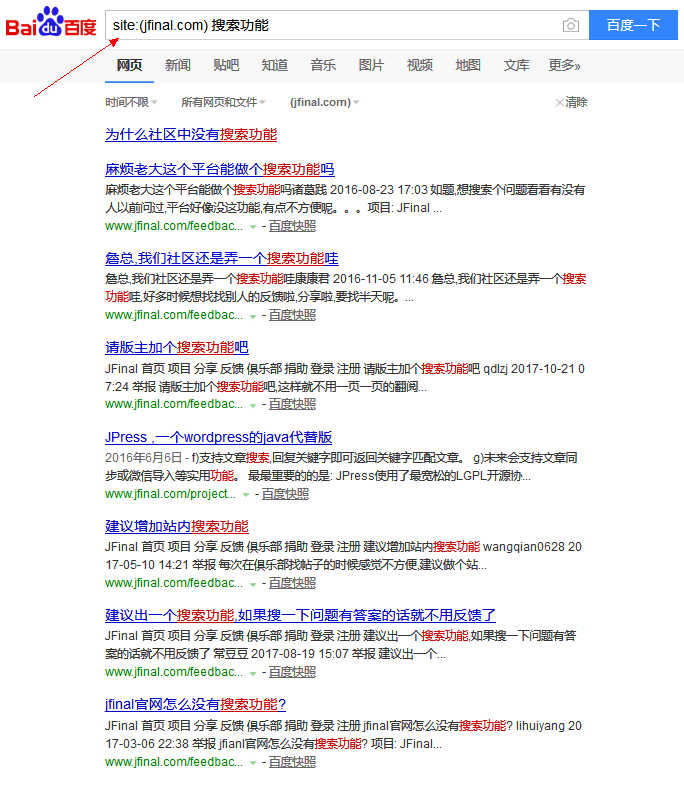2018-02-09 17:57
加入 俱乐部 啊,
jfinal-club 是官方出品的唯一 JFinal 最佳实践,绝无仅有的极简设计,获得 jfinal-club 也就获得了作者本人对 JFinal 的使用精髓。
2018-02-05 21:35
问题一,拿到plugins :
1, 在 /WEB-INF/web.xml 里面有 一个继承自JFinalConfig类的子类,该类用于对整个web项目进行配置。
例如手册: 2.1 概述
2,找到public void configPlugin(Plugins me) 方法:
2.5 configPlugin(..)
参数列表Plugins me 就是它了。
当然 new Druidplugin (...) 一般也在这里写的, 所以直接用就好。
问题二,Druidplugin 是否有方法支持:
源码中有这个方法:防SQL注入:"wall"
/**
* 设置过滤器,如果要开启监控统计需要使用此方法或在构造方法中进行设置
*
* 监控统计:"stat"
* 防SQL注入:"wall"
* 组合使用: "stat,wall"
*
*/
public DruidPlugin setFilters(String filters) {
this.filters = filters;
return this;
}
public DataSource getDataSource() {
return ds;
}
2018-02-02 17:28
@vtjj3213
3X版已经不推荐使用nextHandler了, 赶快升级吧~
/**
* Use next instead of nextHandler
*/
@Deprecated
protected Handler nextHandler;
搜索功能:
2018-02-02 13:37
package com.xxx.common.handler;
import javax.servlet.http.HttpServletRequest;
import javax.servlet.http.HttpServletResponse;
import com.jfinal.handler.Handler;
public class JfHandler extends Handler {
@Override
public void handle(String target, HttpServletRequest request,
HttpServletResponse response, boolean[] isHandled) {
if (target.startsWith("/jf/")) {
next.handle(target, request, response, isHandled);
}
}
}
2018-02-01 10:02
想不报错 只需要在后面加个 true
getBean(Class beanClass, boolean skipConvertError)
getBean(beanClass, true)
不贴异常信息还得猜。。
看看源码:打个断点进去看看吧~
public static T injectBean(Class beanClass, HttpServletRequest request, boolean skipConvertError) {
String beanName = beanClass.getSimpleName();
return (T)injectBean(beanClass, StrKit.firstCharToLowerCase(beanName), request, skipConvertError);
}
@SuppressWarnings("unchecked")
public static final T injectBean(Class beanClass, String beanName, HttpServletRequest request, boolean skipConvertError) {
Object bean = createInstance(beanClass);
String modelNameAndDot = StrKit.notBlank(beanName) ? beanName + "." : null;
TypeConverter converter = TypeConverter.me();
Map parasMap = request.getParameterMap();
Method[] methods = beanClass.getMethods();
for (Method method : methods) {
String methodName = method.getName();
if (methodName.startsWith("set") == false || methodName.length() <= 3) { // only setter method
continue;
}
Class[] types = method.getParameterTypes();
if (types.length != 1) { // only one parameter
continue;
}
String attrName = StrKit.firstCharToLowerCase(methodName.substring(3));
String paraName = modelNameAndDot != null ? modelNameAndDot + attrName : attrName;
if (parasMap.containsKey(paraName)) {
try {
String paraValue = request.getParameter(paraName);
Object value = paraValue != null ? converter.convert(types[0], paraValue) : null;
method.invoke(bean, value);
} catch (Exception e) {
if (skipConvertError == false) {
throw new RuntimeException(e);
}
}
}
}
return (T)bean;
}
2018-01-30 18:20
@lyq027 分开执行啊,当成两步进行业务处理。
1 先使用ajax去触发“执行操作”,这时你可以使用loading效果。
2 当“执行操作”执行完毕后返回 成功或失败。
3 ajax的回调函数判断 返回结果是成功,就触发 js 的模拟表单提交进行直接下载文件
2018-01-30 16:32
社区发展很快,迎来很多刚上手的朋友, 但是根据我经常泡社区来看,很多朋友都不是很会提问啊! 这里分享一篇玉伯老师送给我们的礼物~ 希望大家都签收一下~如何向开源社区提问题使用软件产品,或多或少都会遇到问题。对于商业产品,我们可以咨询客服寻